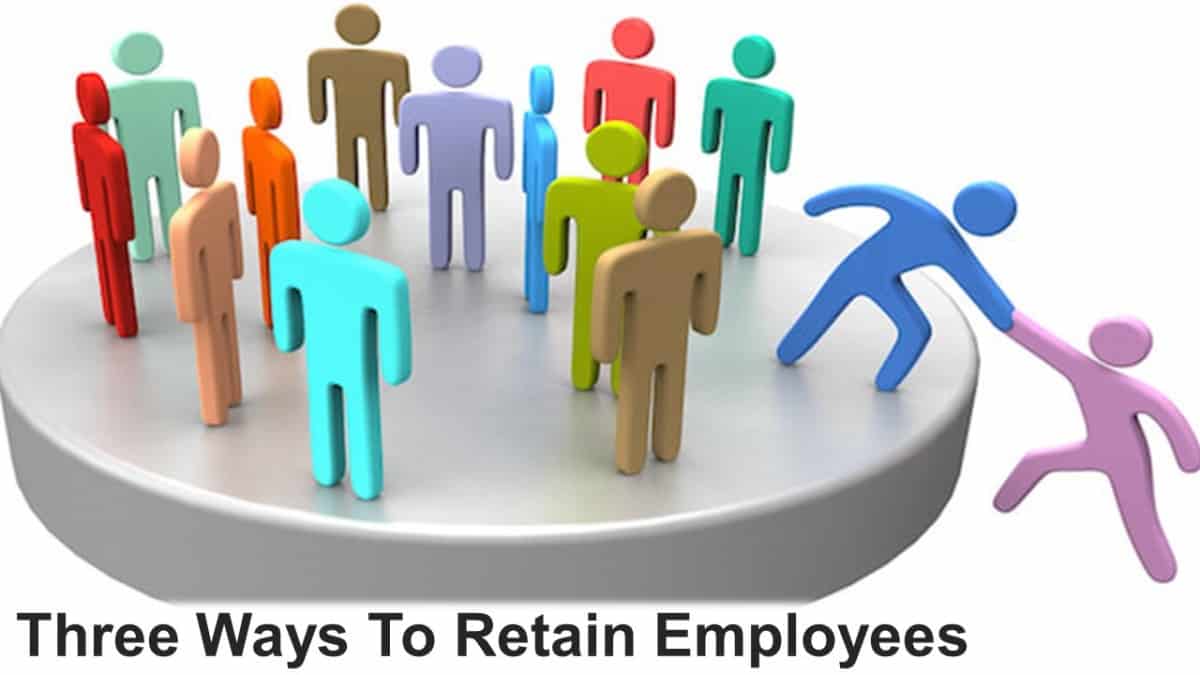Share:
Dr. Troy Hall, Contributor

Has your organization experienced record numbers of resignations in 2021 and 2022? Finding it difficult to retain your top talent? Seeking ways to keep your employees as their values have shifted?
In a March 2022 article for SHRM.org, Roy Maurer asserted that people are still quitting at a rate of over 4 million a month.
Morgan Smith reported for cnbc.com that 40% of workers will consider quitting their jobs each month throughout this year as cited in a report from McKinsey and Company published in July 2022.
There are three ways to retain employees and stop the talent swap. By infusing the three strategic elements of cohesion—belonging, value, and mutual commitment—into their cultures, it creates increased levels of performance and high engagement among team members, reducing rates of turnover.
According to Leslie Webb, VP of People and Strategy for United Bay Community Credit Union in Bay City, Michigan, “Our organization has benefited greatly from infusing cohesion into our culture. We have experienced a deeper level of conversation and commitment within our teams by implementing and practicing principles related to cohesion.”
These high-performing work environments retain talent because the organization’s culture transforms work environments into safe workplaces where people:
- Develop a sense of belonging
- Are valued through meaningful work
- Align personal and corporate goals and objectives to achieve shared mutual commitments
In this article, I’ll explore these three strategic elements of cohesion and how they can boost retention.


Cohesion is a Casual Phenomenon
The best predictor of behavior is finding a cause-and-effect action catalyst.
My dissertation focused on group dynamics and the impact of cohesion within a team’s life cycle. The research hypothesis validated that when cohesion was present in any stage of a group’s existence, performance always followed.
Meaning that cohesion caused performance through a level of employee engagement that was helpful, active, vested, and eager.
Gallup released new retention data in the spring of 2022, citing that engaged employees are 44% more likely to stay at their present employer than those who are faking it to make it.
When HR strategies, practices, and educational development focus on cohesion, organizations can effectively stop the talent swap and start retaining their talent. A culture of cohesion provides many benefits, to include: reducing absenteeism, increasing productivity and creativity, and controlling turnover costs.
Why Cohesion and Not Happiness or Satisfaction?
For years, organizational leaders have been wooed with correlational data and statistics encouraging them to focus on making employees happy or satisfied, often citing that a satisfied employee is an engaged one.
In an article written by Jim Harter and Annamarie Mann for the Gallup Business Journal, they have concluded (paraphrased), “…engagement is not determined by an abstract feeling … measuring a worker’s contentment, happiness levels or catering to their wants, often fails to achieve the goal of engagement.”
Quite frankly, an employee who happily shows up to work on time, does what they need to do, and doesn’t bother the boss very much is not necessarily a satisfied or engaged employee.
What we have observed is an employee who shows up to work, does what’s needed, and ends the day with minimal supervision.
Engaged employees look for ways to assist fellow colleagues, are active in accomplishing work-related tasks, take pride in their work, are proud of where they work, and are eager to learn more and apply that knowledge across the organization.
While it is a great and noble cause to try and make people happy or satisfied, the emphasis is misplaced because the employer is attempting to find ways to control others’ feelings.
Instead, leaders should put their efforts into building a safe workspace that allows employees to offer ideas and opinions and contribute to solutions, have meaningful work that brings forth the employee’s work passion, and aligns personal goals with desired corporate outcomes that satisfy people’s need to affiliate and achieve.
Leaders should only be concerned with whether they are a reason for the employee to become unhappy or dissatisfied. The final outcome is always in the purview of the employee.
Casual Versus Correlational Data
Causal data implies that a specific element (the cause or why) brings about an outcome (effect or the what).
Take the classic example of Newton. He observed an apple falling from a tree and wondered why it fell down instead of up or sideways. Newton discovered the cause and effect of gravity.
The apple and gravity are not correlational. Gravity is causal and one can predict with assurance that what is up will eventually come down.
Correlational data reflects a statistical relationship between two or more variables. Take the relationship between rainy days and umbrellas.
Ask yourself these questions, “Do you always open an umbrella on a rainy day? When you open an umbrella on a beach does it cause it to rain?” The answer to both is “no.”
One can make an argument that there is a strong correlation between rainy days and umbrellas and even forecast the likelihood of selling umbrellas when it rains, but the relationship between the two variables will always remain statistical and correlational.
Opened umbrellas do not cause it to rain and rainy days do not cause umbrellas to be opened.
However, when a team operates through a cohesive lens where belonging, value, and shared mutual commitments are present, then performance is always the outcome. Cohesion is the causal catalyst.
Performance becomes the reaction. Therefore, Cohesion = Performance.
Belonging, Value, and Mutual Commitment
During a conversation with Star Ross, SHRM-SCP president of Palmetto SHRM in Charleston South Carolina, she expressed this sentiment, “I have totally drunk the Kool-Aid on the power of cohesion in talent retention. Time for more business leaders to take a sip.”
Belonging
“Belonging” is the concept that people have an affinity for a place or situation. It is a feeling that they are part of something special and believe they are included.
Organizations can begin fostering this concept through the simple and practical application of cohesion greetings. This is more than your casual, “Hello, how are you
It goes beyond the synthetic acknowledgment one receives in passing to developing the types of cohesive touch bases that bring forth connection before content.
When speaking with leaders at Duke Manufacturing in Prague about making lasting employee connections, the leaders explained that employee surveys continuously received comments on how important it was for company leadership to greet them.
They further explained that it wasn’t just a cursory hello. In fact, employees did not care if the leader remembered their name, the number of children they had, or a special birthday or anniversary.
What was important is how the leader made the employee feel.
They valued the leader taking time to speak with them and ask about the culture, their wins for the day, what obstacles they faced, and what the leader could do to make Duke Manufacturing a better place to work.
Value
This strategic element goes beyond extending trust and respect and reflects how a person feels about their work. It has nothing to do with money.
A popular opinion shared in articles and dialogue within social media outlets tout the cause of this resignation wave due to an employee’s dissatisfaction with their pay.
Oftentimes, during the two-week notice, the resigning employee gives a reason such as “I am leaving for a better opportunity with the chance of making more money.”
Several of my peers have been part of the talent swap over the past 18 months.
Although they told their employers they were leaving for a “better opportunity and more pay” the real reason was due to office antics, lousy relations with their supervisor, and a work culture that did not promote belonging, value, or mutual commitments.
These employees were not given the chance to feel like they were part of something special, that they had meaning and purpose in what they did, nor were they able to share in mutual commitments because goals were only focused on desired corporate outcomes and did not take personal ambitions and objectives into consideration.
For the most part, employers have believed the real reason people leave is because of pay.
In response to this belief, leaders have utilized the strategy of “throwing money at the problem.” Some organizations have tried to woo workers with higher wages, shorter work weeks, and elevated premiums for paid time off.
This has created an unprecedented rise in employment costs that will be difficult for leaders to bring down without diverting the burden to the everyday consumer in the form of increased prices for products and services.
But, leaving for money is not the primary value reason.


Three researchers, Sull, Sull, and Zweig, from MIT Sloan Management Review analyzed 34 million online employee profiles.
They scoured the data looking for answers to why employees are continuing to leave their current workplace. In fact, the researchers concluded a number of significant reasons people leave, and salary-related issues ranked 16th on the list
The researchers further support the notion that culture is a “more reliable predictor” to promote turnover than how employees feel about their pay. Again, this goes back to Simon Sinek’s correlation between fulfillment and belonging.
Top predictors of attrition relating directly to culture are job insecurity (toxic or hostile environments), failure to recognize performance (lack of inclusion), lack of job autonomy, limited or no opportunity for job growth development or advancement, and inflexible work locations and hours
Actually, people want to know that what they do matters and why it matters. It is important that the work is meaningful and purposeful.
Embedded within a cohesion value statement, it must convey both achievements of tasks and the quality of the person. So, before an organization tries to buy employees with salary increases, spend effort developing employee value through a company-wide “Affirmation Program.”
Affirmations feed the internal feelings and emotions of the employee that connect their passion to the purpose of the job.
Affirmations are more than just a high-five, fist bump, or pat on the back. To extend a successful affirmation, it must contain two specific parts: a) recognition of the employee’s job (role/task), and b) appreciation of who the person is (identity).
Both parts are needed to affirm achievement.
Too often, employees only hear how good they did after completing a task, like “Atta Boy” or “Atta Girl.” There is nothing wrong with acknowledging only the work, but the real power comes when the recognition of the role is combined with the appreciation of who they are.
By including both role and identity in the affirmation, the individual receives a value statement of achievement and adopts the feeling of being fulfilled
Simon Sinek claims that when people are fulfilled, they tend to come to an emotional connection that resembles “loving their job.” This love for their job binds them to the organization.
When people experience positive feelings for where they work, they tend to find comfort in belonging and increased levels of self-esteem (value) because their psychological and protection needs are met.
They move toward self-actualization in exactly the way Maslow’s Hierarchy of Needs Theory first explained in 1943.
Mutual Commitment
Mutual commitment occurs as part of a reciprocal process when the focus is on others first, then self. It is more than just one or more people agreeing to complete a project or a task.
It is the alignment of personal goals and desired corporate outcomes. When the emphasis becomes too one-sided, in either direction, then the mutuality of the commitment is no longer in place.
This was clearly felt by employers during the “Great Resignation.” Although I question if that moniker truly reflects the whole story.
As the job turnover trend continues to evolve, I see it more like the “great ReCALIBRATION of mutual commitment.” Meaning that folks did not up and quit just to stay home, sit on the couch eating potato chips, and stream their favorite series.
What happened is that workers said “no” to toxic work cultures, unfulfilled dreams of advancement, sedimentary work surroundings, and leadership that only focused on what was important to the company.
There was a complete lack of mutuality and a shared desire to work in tandem. In effect, employees recalibrated how they wanted to do work, where they wanted to do it, and with whom.
Workers exercised a workforce expectation called “the entrepreneurial spirit” that reflected a demand for flexible work hours and locations, more autonomy, and a commitment towards individual growth, development, and advancement.
One of the biggest opportunities for organizations to start building shared mutual commitments and demonstrate a willingness to put others first before the company occurs during onboarding.
Too often the organization spends most of those crucial first impressions explaining what needs to be done, which systems to use, how to access the systems and a thorough review of the policy and procedure manual.
To combat a one-sided commitment, leaders must explain to the employee their future with the company and how the business is expected to evolve over the next three to five years.
Over 71% of all employees (not just new hires) expect to grow, develop, and advance themselves, or feel assured that they are working for a company with a focus on the future.
If the onboarding process does not cover this within the first few days of the new hire process, the organization is missing an excellent opportunity to solidify the first and most important shared mutual commitment—our future together.
Understanding the future direction of the organization and the person’s career trajectory gives employees the reassurance of job security and the possibility of earning more as the company grows.

Featured on The Today Show, ABC, the Global BV-TV Network, Beyond the Business Radio Show, and CEO World, Dr. Troy Hall is an award-winning talent retention consultant, international speaker, and author of the bestselling titles, Cohesion Culture: Proven Principles to Retain Your Top Talent, and Fanny Rules: A Mother’s Leadership Lessons That Never Grow Old.
As the founder of Cohesion Culture™, Dr. Troy has dedicated his career to establishing a cycle of culture wellness in the corporate and professional sphere. His consulting and executive coaching engagements are built on the strategic framework of Cohesion Culture™, making the concepts of belonging, value, and shared commitment easy for organizations to adopt and implement. From the U.S. to Canada and the United Kingdom, from the Middle East to Africa, Asia, Europe, and Australia, Dr. Troy has spoken at global conferences as a subject matter expert on the topics of culture & leadership, strategy, and change.


